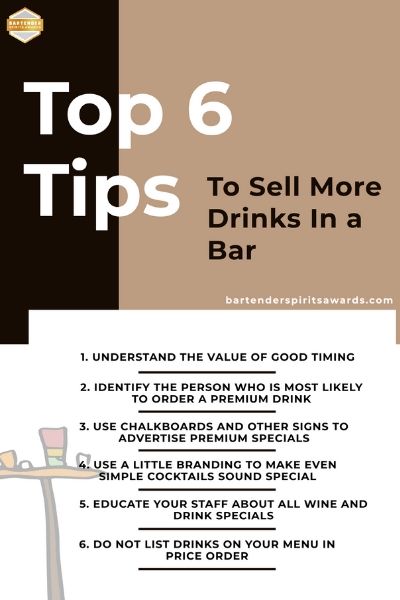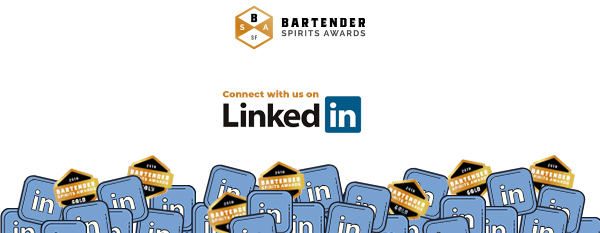
09/12/2020 Here’s a brief guide to selling more drinks in a bar.
For any on-premise establishment, the easiest way to boost bottom-line profitability is by finding unique and creative ways to upsell customers on more expensive drinks. In some cases, that means encouraging customers to purchase wine instead of beer, and in other cases, it means getting customers to order specialty cocktails made with premium spirits.
With that in mind, here’s a brief guide to selling more drinks in a bar.
#1: Understand the value of good timing
Getting a customer to order a second drink is almost always a more difficult task than getting the initial order filled. The reason has a lot to do with human psychology. If there are two or more people at a table, the person with the empty glass will inevitably look at the glasses of the other person (or other people) at the table and perform an incredibly quick cost-benefit analysis. If the other person’s glass is two-thirds full, they will probably conclude that they have plenty of time to order a second drink and finish it by the time the other person has completed his or her drink. But what if the other person’s glass is less than half full? Or, even worse, what if it is nearly empty? It’s going to be a lot harder to make an additional drink sale. That’s why the standard rule of thumb is to sell to the person with the empty glass when his or her companion’s glass is as full as possible. The longer you wait, the less likely you are to make the final sale.
#2: Identify the person who is most likely to order a premium drink
This tactic is called “identify the premium purchaser” and it, too, relies on a little human psychology to work. If a server starts taking drink orders, and the first person orders a non-alcoholic drink (such as sparkling water or iced tea), then it is much more likely that everyone else at the table might decide to order a similar type of non-alcoholic drink. However, the whole dynamic changes considerably if the first place placing an order decides to order a premium cocktail drink. Then, there is a much greater likelihood that everyone else will “match” that order. What this means for a server is that the easiest way to increase the size of a drink tab is to find the person at the table most likely to order an expensive, premium drink, and then wait as everyone else follows the lead of that person.
#3: Use chalkboards and other signs to advertise premium specials
With the exception of beer, most people do not always know what they are going to order when they walk into a restaurant, bar, wine bar or nightclub. Thus, you have a lot more flexibility than you might think to influence those decisions. For example, simply highlighting a chalkboard near the bar with special offers and promotions can help to sway a purchase decision at exactly the point of purchase. The key, of course, is to give these subtle clues and reminders as close as possible to the point of purchase (such as right on the table, next to the silverware), and not just at the entrance to the establishment.
Let's Connect
#4: Use a little branding to make even simple cocktails sound special
Ever wonder why so many bars and restaurants come up with elaborate names for every cocktail they serve? The answer is that a little branding can go a long way. For example, simply ordering a “rum and coke” doesn’t sound nearly as attractive (or exotic) as calling it a “Cuba Libre.” And you could go one step further, by adding an extra garnish (or two), using special glassware, and naming the drink something completely different, like “Hemingway’s Havana Surprise,” that sounds even more romanticized and special. Once you’ve done that, you’ve psychologically primed the customer to pay more for a premium drink, simply with better branding.

#5: Educate your staff about all wine and drink specials
The better educated and more knowledgeable than your staff is, the more likely they will be to upsell consumers about drinks and cocktail specials. This is especially important if you are adding new spirits or new cocktails to your menu. The general rule of thumb is that two training sessions are required every time you are changing the content of a cocktail menu. This is to ensure that all serving staff is aware of not just what a particular drink tastes like, but also how it is made, and what types of ingredients are most notable within the drink.
#6: Use different marketing tactics for different purposes
One of the most typical promotions found at bars and restaurants is the “2-for-1” promotion, in which a patron gets 2 beers, wines or cocktails for the price of one. This is a marketing tactic specifically designed to bring in foot traffic and get people in the door. However, once the patron is inside the establishment, you will need to think of other marketing tactics that help to convert patrons into purchasers of premium drinks and spirits. One example of this might be a special promotion that incentivizes this type of premium purchase – such as ordering a specialty cocktail in order to be entered into a lottery prize draw or product giveaway sponsored by your establishment.
#7: Do not list drinks on your menu in price order
Most people, when they examine a menu, will instinctively review drinks in linear order. They might start at the top of the page and work their way down, or they might start at the bottom and work their way up. This is a quick, easy way to find either the cheapest or most expensive item on the menu. It’s common and it’s typical, but it also conditions patrons to think only in terms of price. Thus, do not list your drinks in price order. When servers approach a table and are asked what beers are available, they should never start with a list of the cheapest domestic beers. Or when they are asked about wine or cocktail specials, they should be able to recite specials according to some other factor (such as the spirit used to make the cocktail, or the type of flavor of the cocktail).
#8: Create different drinks for men and women
While it might be politically correct to say that men and women are just as likely to order the same type of cocktail, practical and anecdotal evidence suggests otherwise. While men naturally gravitate towards dark spirits (e.g. whiskey, rum), women prefer cocktails that are served in special glassware, with special garnishes. They also prefer “fun” and “fruity” drinks that are usually on the sweet side or that are specifically designated as “low-calorie.”
So if you know that your clientele has a lot of female patrons, you definitely want to make sure that you are providing them options. Even something very simple – such as serving a wheat beer with a bright orange slice – could convince other female drinkers at the table to order a beer that night.
#9: Offer perceived value
Value can be defined in many different ways. For some people, “value” is synonymous with something that is affordably priced. But value is really an inherent characteristic that is relative. For example, a $12 cocktail might sound expensive relative to the domestic or imported beers on your menu, but would be an attractive value if all the other cocktails on your menu are priced at $15, $18 or $20. There have actually been quite a few studies done on how consumers make choices, based on pricing and the number of options available. What they have found is that you can often influence a purchasing decision by giving three options. People will often gravitate toward the middle-range option rather than settling for the low-priced option or splurging on the expensive option.
#10: Create the right ambiance
Finally, one way to sell more drinks in a bar is simply by maintaining the establishment and making it a pleasant place to enjoy a glass of wine or cocktail. This goes for every aspect of the customer experience. Is the glassware clean and new? Are beers served properly chilled? Are tables clean and presentable? All of these factors can go into the decision of how long patrons stay for the evening or night.
And, of course, the longer they stay, the more likely it is that you will be able to increase the size of the final drink tab. At restaurants, for example, a particularly convivial and festive night might lead to someone ordering a drink with dessert, or ordering a digestif. But if a restaurant is crowded, if it is clear that servers are trying to free up new tabletops, and if drinks are being served in a haphazard manner or in old glassware, all of that helps to decrease the attractiveness of ordering another drink.
There is plenty of value in selling more drinks, especially if they include premium spirits. Using the steps above, you can maximize the revenue potential of your on-premise establishment and increase the likelihood that patrons will spend more, tip better, and decide to return again soon.




